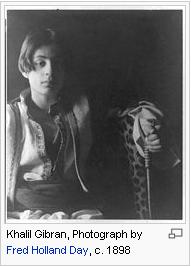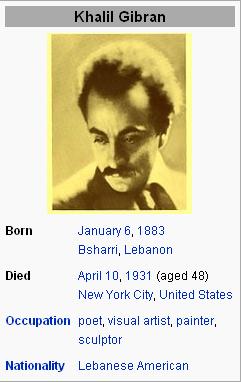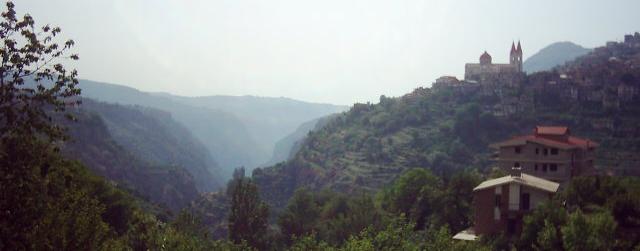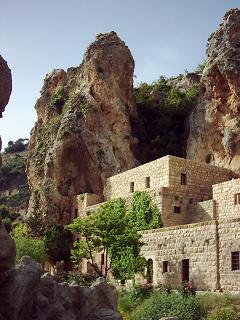|
|
|
|
Mieh w Mieh
- Gibran Khalil Gibran
Gibran Khalil
Gibran Lebanese Writer, Painter & Sculptor, said once:
A little knowledge that acts is worth infinitely more than
much knowledge that is idle. |
|
|
|
|
|
|
|
|

|
Gibran Khalil
Gibran was born on January 6th, 1883 in the village of
Bsharre, in Northern
Lebanon, next to the holy
Qadisha Valley,
and the Holy Cedars of Lebanon.
|
| |
|
At the age of
eight, Khalil Gibran, Gibran's father, was accused of tax evasion and was sent
to prison as the Ottomon authorities confiscated the Gibrans' property and left
them homeless. The family went to live with relatives for a while; however, the
strong-willed mother decided that the family should immigrate to the U.S.,
seeking a better life and following in suit to Gibran's uncle who immigrated
earlier. The father was released in 1894, but being an irresponsible head of the
family he was undecided about immigration and remained behind in Lebanon.
|
|
On June 25, 1895, the Gibrans embarked on a voyage to the
American shores of New York. The Gibrans settled in Boston's South End, which at
the time hosted the second largest Syrian community in the U.S. following New
York. The culturally diverse area felt familiar to Kamila, who was comforted by
the familiar spoken Arabic, and the widespread Arab customs. Kamila, now the
bread-earner of the family, began to work as a peddler on the impoverished
streets of South End Boston. At the time, peddling was the major source of
income for most Syrian immigrants, who were negatively portrayed due to their
unconventional Arab ways and their supposed idleness. |
| |
|
 |
|
Qadisha Valley or Wadi Qadisha - Gibran
childhood great inspiration |

|
|
In the school, a registration mistake altered his name
forever by shortening it to Kahlil Gibran, which remained unchanged till the
rest of his life despite repeated attempts at restoring his full name. Gibran
entered school on September 30, 1895, merely two months after his arrival in the
U.S. Having no formal education, he was placed in an ungraded class reserved for
immigrant children, who had to learn English from scratch. Gibran caught the eye
of his teachers with his sketches and drawings, a hobby he had started during
his childhood in Lebanon. |
|
|
Bsharre under
snow. |
| |
|
Gibran Museum
at Bsharre |

|
| |
|
 |
|
Gibran's curiosity led him to the cultural side of Boston,
which exposed him to the rich world of the theatre, Opera and artistic
Galleries. Prodded by the cultural scenes around him and through his artistic
drawings, Gibran caught the attention of his teachers at the public school, who
saw an artistic future for the boy. They contacted Fred Holland Day, an artist
and a supporter of artists who opened up Gibran's cultural world and set him on
the road to artistic fame...
Lebanese-American philosophical essayist, novelist, mystical
poet, and artist.
Gibran's works were especially influential in the American
popular culture in the 1960s. In 1904 Gibran had his first art exhibition in
Boston. From 1908 to 1910 he studied art in Paris with August Rodin. In 1912 he
settled in New York, where he devoted himself to writing and painting. Gibran's
early works were written in Arabic, and from 1918 he published mostly in
English. In 1920 he founded a society for Arab writers, Mahgar (al-Mahgar).
Among its members were Mikha'il Na'ima (1889-1988), Iliya Abu Madi (1889-1957),
Nasib Arida (1887-1946), Nadra Haddad (1881-1950), and Ilyas Abu Sabaka
(1903-47). Gibran died in New York on April 10, 1931. Among his best-known works
is THE PROPHET, a book of 26 poetic essays, which has been translated into over
20 languages. The Prophet, who has lived in a foreign city 12 years, is about to
board a ship that will take him home. He is stopped by a group of people, whom
he teaches the mysteries of life.
Gibran Khalil Gibran (1883 - 1931)
Gibran Khalil Gibran (1883 - 1931)
Gibran Khalil Gibran (1883 - 1931) |
|
|
| |
|
|
|
|
| |
|
|
|
|
| |
|
|
|
|
|
|
|
|
|

|
|
|
|
|
|
|
|
|
|